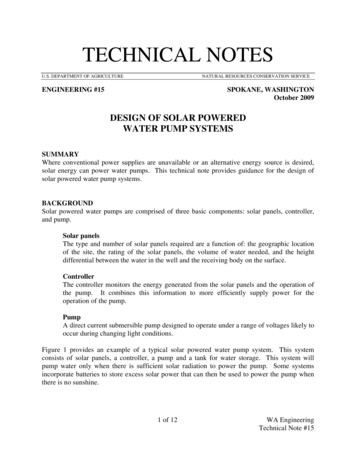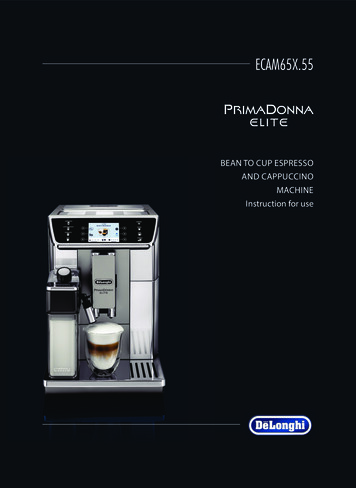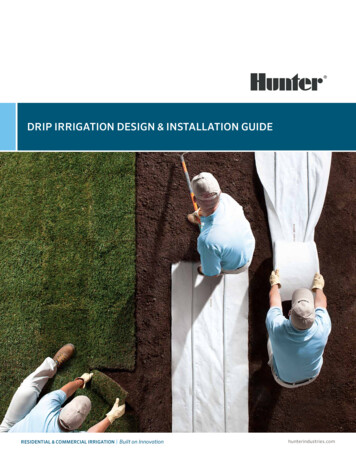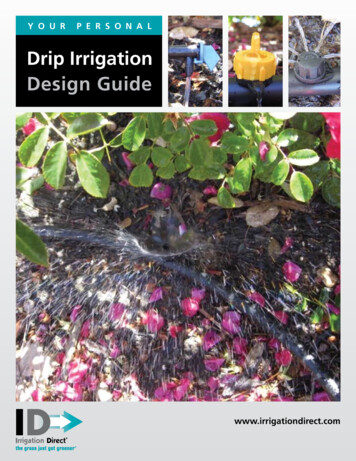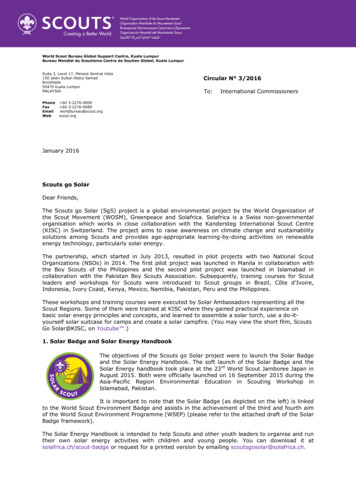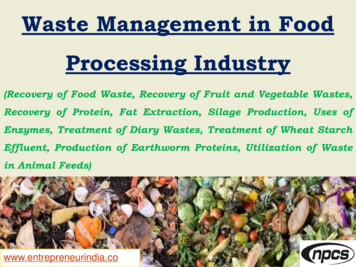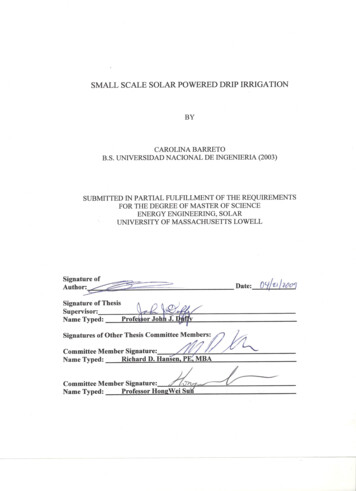
Transcription
SMALL SCALE SOLAR POWERED DRIP IRRIGATIONBYCAROLINA BARRETOABSTRACT OF A THESIS SUBMITTED TO THE FACULTY OF THE ENERGYENGINEERING PROGRAM IN PARTIAL FULLFILMENT OF THEREQUIREMENTS FOR THE DEGREE OF THE MASTER OF SCIENCEENERGY ENGINEERING, SOLARUNIVERSITY OF MASSACHUSETTS LOWELL2008Thesis Supervisor: John J. Duffy, D. Sc.Professor, Solar Engineeringi
ABSTRACTThe aim of this study is to provide small farmers in developing countries with anaffordable irrigation method that promotes the sustainable use of water and energy. Tosustain the world in the future, 60% of the food required must come from irrigatedagriculture; and developing countries hold three quarters of the total world’s irrigatedarea where small farmers cultivate half of this agricultural land and 80% of thispopulation lacks electricity services. This study presents a solar drip irrigation design andinstallation of a 5000m2 asparagus plot in Turripampa, Huarmey, Peru. The PenmanMonteith method was used to match the plant’s water requirement with the photovoltaicpumping. The system was designed based on finding low cost (but robust) componentsthat can make it affordable. A cost/benefit comparison is made between the systemproposed and the base scenario of the agricultural common practices such as gravity fedsystems and diesel pumping.ii
TABLE OF CONTENTSABSTRACT. iiLIST OF TABLES . viLIST OF ILLUSTRATIONS . viiI.INTRODUCTION .1I.1.Objective. 5I.2.Approach . 5II. BACKGROUND OF THE DIFFERENT COMPONENTS AND APPROACHES:PV PUMPS, DIESEL MOTORS, FLOODING, SPRAY AND DRIP IRRIGATION. .7II.1. Rural electricity in developing countries . 7II.1.1.II.2.Energy and Irrigation in small holder agriculture in developing countries . 12Watering methods for irrigation . 19II.2.1.Water sources . 22II.2.2.Methods of irrigation . 23II.2.2.1.Surface irrigation . 24II.2.2.2.Sprinkler irrigation . 26II.2.2.3.Trickle irrigation . 29II.2.3.Crop’s water requirement . 31II.2.3.1.Evapotranspiration (ET) . 34II.2.3.2.Reference crop evapotranspiration (ETo) . 39II.2.3.3.Crop evapotranspiration under standard conditions (ETc) . 40II.2.4.Crop evapotranspiration under non-standard conditions (ETc adj) . 42II.2.4.1.Energy balance and microclimatological methods. 43II.2.4.2.Soil water balance . 45II.3.Types of pumps for irrigation and principles of operation . 48II.3.1.Radial flow pumps . 53II.3.2.Axial flow pumps . 62II.3.3.Positive displacement pumps . 65iii
II.3.4.Manual pumps . 65II.3.5.Motorized pumps . 71II.3.5.1.Diaphragm pumps . 71II.3.5.2.Mono pumps (Helical) . 73II.4. Power units . 75II.4.1.Electric motors . 76II.4.2.Solar photovoltaic . 77II.4.2.1.The Effect of Varying Solar Radiation On Output . 78II.4.2.2.Solar Photovoltaic pumping (PV) . 78II.4.3.Wind powered pumps (mechanical and electrical). 81II.4.3.1.Mechanical windpumps. 81II.4.3.2.Characterization of Windpump Types . 81II.4.3.3.Wind rope pump . 82II.4.3.4.Wind-electric pumping for farming . 86II.4.4.Internal combustion engines . 88II.4.4.1.Diesel engines . 88III. THE SYSTEM DESIGN, INSTALLATION AND TESTING .91III.1.Pump selection. 91III.2.FAO Penman-Monteith method . 93III.3.Data. 97III.3.1.Radiation, Wind and Temperature . 98III.4.Stand alone photovoltaic pumping . 100III.5.Asparagus evapotranspiration matched with solar drip irrigation . 103III.5.1.Crop coefficient approach . 104III.6.Water and energy storage . 108III.7.Mathematical model of the pump . 110III.8.The system’s components and installation . 111III.8.1.System Controls . 112III.8.2.Timer (Diehl Control) Series 884. 113III.8.3.Charge controller . 114III.8.4.Pressure switch . 114III.8.5.Pressure tank . 115III.8.6.Tank float valve . 116III.8.7.Number of modules needed. 116iv
III.8.8.Wiring considerations . 117III.8.9.Irrigation tape (pipes) . 120IV. ECONOMIC ANALYSIS .124IV.1.Constraints in small farming financing . 124IV.1.1.The property of land . 125IV.1.2.Water, Electricity and other bills. 125IV.1.3.Lack of technological assessment . 126IV.2.Solar Drip irrigation system payback, IRR, NPV and B/C . 126IV.2.1.Solar drip irrigation scenario . 129IV.2.2.Diesel drip irrigation scenario . 129IV.2.3.Diesel furrow irrigation scenario. 130IV.2.4.Gravity fed system . 131IV.3.IV.3.1.Oil prices fluctuations . 133IV.3.2.Crop prices fluctuations . 134IV.4.V.Results of the economic analysis . 131Turripampa system. 135DISCUSSION, CONCLUSIONS, AND RECOMMENDATIONS .138V.1. Risks and sustainability strategies . 140VI. LITERATURE CITED .142VI.1.Literature used but not cited . 143VII. APPENDIX .144MathCad Calculations. 144Solar Drip Irrigation Pumping Design . 144Calculation of Eto: FAO Penman Monteith method. 154ETc Calculation of crop evapotranspiration under standard conditions for a singlecrop coeffieicnt Kc (Furrow and Sprinkler) and doble coefficient for Drip . 167PV power operating point . 181Calculation for a Permanent magnet Shurflo pump at a steady state with: . 183Piping System from the pump to the tank. 185Drip Irrigation design. 188VIII.BIOGRAPHICAL SKETCH OF THE AUTHOR .192v
LIST OF TABLESTable II-I Typical field application efficiencies for irrigation methods (Kay & Hatcho,1992) . 25Table II-II Typical sprinkler data (Kay & Hatcho, 1992) . 28Table II-III Average ETo for different agroclimatic regions in mm/day. 41Table II-IV- Pressure treadle pump test analysis . 67Table II-V- Pumping Capacity of the rope pump according to depth (de Jongh & Rijs,1999): . 71Table II-VI- Characteristics of the three classes of windpumps: The"American" windmill,the second generation windpump and the artisanal windpump type . 82Table II-VII- The different windpump models in production by the workshopAerobombas de Mecateh in Managua (AMEC). The output figures are based upon thedocumentation provided by the manufacturer, for a wind speed of 5 m/s . 85Table III-I Watering methods and diaphragm pump capacity . 106Table III-II PVXTOOL results . 109Table III-III Timer specifications . 113Table III-IV Voltage drop for copper conductors . 118Table III-V Recommended operating pressures . 122Table IV-I Economical analysis. 131Table IV-II. Economical analysis summary for the solar drip irrigation option . 136vi
LIST OF ILLUSTRATIONSFigure II-1 Global energy poverty (IEA, 2002) . 7Figure II-2 The link between poverty and electricity access (IEA, 2002). . 9Figure II-3. Average per capita final energy consumption and share of population livingunder poverty line (IEA, 2002). . 10Figure II-4. Illustrative example of household fuel transition (IEA, 2002). . 11Figure II-5 Comparison of yields and water productivity of wheat in USA, India andPakistan(Kijne, Molden, & Barker, 2003) . 14Figure II-6 Competing water uses for main income groups of countries (The UnitedNations, 2003) . 15Figure II-7 Comparison of yields and productivity for rainfed, irrigation andsupplemental irrigation (Kijne, Molden, & Barker, 2003) . 16Figure II-8 Critical fresh water withdrawals in developed and developing countries.(Kijne, Molden, & Barker, 2003). 17Figure II-9. Causes of food emergencies in developing countries (Kijne, Molden, &Barker, 2003) . 18Figure II-10 Choosing irrigation system components . 20Figure II-11 Basin, border and furrow irrigation (Kay & Hatcho, 1992) . 26Figure II-12 Sprinkler irrigation (Kay & Hatcho, 1992) . 27vii
Figure II-13 Hose-pull sprinkler system (Kay & Hatcho, 1992) . 29Figure II-14 Drip irrigation layout . 30Figure II-15 Schematic representation of a stoma (Allen & Pereira, 1998) . 32Figure II-16 The partitioning of evapotranspiration into evaporation and transpirationover the growing period for an annual field crop (Allen & Pereira, 1998) . 33Figure II-17 Factors affecting evapotranspiration with reference to related ET concepts(Allen & Pereira, 1998). 35Figure II-18 Reference (ETo) crop evapotranspiration under standard (Etc) and nonstandard conditions (Etc adj) (Allen & Pereira, 1998). . 38Figure II-19 Schematic presentation of the diurnal variation of the components of theenergy balance above a well-watered transpiring surface on a cloudless day . 43Figure II-20 Soil water balance of the root zone . 46Figure II-21 Subclassification of pump types as a function of operating head anddischarge (Adapted from (Longenbaugh & Duke, 1980)) . 50Figure II-22 Schematic classification of pump types by the State Electricity Commissionin 1965(Sawa & Fenken, 2001). . 51Figure II-23 Schematic classification of pump types by the Hydraulic Institute in 1983(Sawa & Fenken, 2001) . 52Figure II-24- Cross-section of a centrifugal pump (Sawa & Fenken, 2001) . 55Figure II-25- Pump impellers and volute casing (Sawa & Fenken, 2001) . 55Figure II-26- Classification of volute pumps based on the impeller proportions (Sawa &Fenken, 2001) . 56Figure II-27- Parts of bowl assembly (Sawa & Fenken, 2001) . 57viii
Figure II-28- Different drive configurations (Sawa & Fenken, 2001). 58Figure II-29- Electrically driven turbine pump (Sawa & Fenken, 2001) . 60Figure II-30- Cross-section through a submersible pump and submersible motor (Sawa &Fenken, 2001) . 62Figure II-31- Example of a Jet Pump (Sawa & Fenken, 2001) . 64Figure II-32- Basic principles of positive displacement pumps . 65Figure II-33- Hand pump with single acting bucket and piston . 66Figure II-34- Double acting pressure treadle pump . 68Figure II-35 Double acting non-pressure treadle pump . 69Figure II-36 Schematics of a typical rope pump (de Jongh & Rijs, 1999) . 70Figure II-37How a diaphragm pump works (Jabsco, undated). 72Figure II-38- Schematic diagram of a diaphragm superficial (a) and submersible (b) pump(Jabsco, undated). 73Figure II-39- Schematic diagram of a mono pump unit . 75Figure II-40- PV DC electric generator (adapted from (Thomas, 1996)) . 79Figure II-41- Block diagram of a PV powered water pumping system (adapted from(Thomas, 1996)). 80Figure II-42- Layout of the AMEC H-270 rope windpump, based on (de Jongh & Rijs,1999). Indicated are the following components: the rotor (a); the head assembly and yawbearing (b); the top pulley (c); the tail vane (d) the control rope (e); the tower (f); thetransmission rope (g); the tower (h); the handle for manual pumping (i); the pump shafttransmission pulley (j); the main shaft (k); the pump pulley (l); the pump discharge tube(m) . 84ix
Figure II-43- Rating curves for engine (Sawa & Fenken, 2001) . 90Figure III-1 Shurflo ProBaitmaster 4901-6212. 91Figure III-2 Simplified representation of the (bulk) surface and aerodynamic resistancesfor water vapor flow (Allen & Pereira, 1998). 94Figure III-3 Characteristics of the hypothetical reference crop . 96Figure III-4 Average solar radiation with different slopes . 99Figure III-5 Relation between water requirements and solar radiation . 100Figure III-6 IV curve for a 12 V of a 50W Panel. 102Figure III-7 Relation between PV module production at different slopes and reverencecrop water requirement . 103Figure III-8 Water requirements for different irrigation methods . . 105Figure III-9 Matching Asparagus consumption with PV pumping . 107Figure III-10 Reducing the pump's usage according to the water needs . 108Figure III-11 System’s components in installation . 111Figure III-12 Timer selected for the system (yellow), Charge controller (green) . 113Figure III-13 Pressure switch (pink) and pressure tank (blue) . 115Figure III-14 Tank float valve. 116Figure III-15 PV installation in Turripampa . 117Figure III-16 Sketch of wire diagram . 118Figure III-17 Float pump (Jan 2008) . 119Figure III-18 Pump house . 120Figure III-19 Tank installed at 16m of height. 120Figure III-20 Ro-Drip irrigation tape . 121x
Figure III-21 PE to PVC connectors and seals have to be used to avoid leaks. . 122Figure III-22 Tape attached to the PE to PVC connectors. 123Figure III-23 Water behaviour according to soil type. . 123Figure IV-1 Payback analysis with diesel price at 1 /liter and asparagus 0.7 /kg(Cumulative cash flow vs. years) . 132Figure IV-2 Payback analysis with diesel price at 2 /liter and asparagus 0.3 /kg(Cumulative cash flow vs. years) . 134Figure IV-3 Crop price fluctuations asparagus 0.3 /kg and diesel 1 /l (Cumulative cashflow vs. years) . 135Figure IV-4 Price of Asparagus December, 2008: 0.4 /kg (Cumulative cash flow vs.years) . 137Figure V-1 Proposed sizing methodology used for small solar diaphragm pumps . 138xi
I.INTRODUCTIONThe aim of this study is to provide small farmers in developing countrieswith an affordable, eco-friendly and easy to maintain irrigation method that promotesthe sustainable use of photovoltaic energy. Sixty percent of the extra food required tosustain the world in the future must come from irrigated agriculture (FAO, 1999) 1.Irrigated agriculture provides 40% of world food production on only 17% of totalcultivated land. Third world countries hold three quarters of the total world’s irrigatedarea (260 million hectares), where small farmers (average 3-4 hectares per farm)cultivate more than half of this agricultural land (FAO, 1999). New sites fordevelopment are scarce; therefore, the world’s food security relies largely on theimprovements of irrigation techniques for smallholder agriculture.According to the International Labor Organization (ILO-FAO, 2008), 3 ofevery 4 poor people in developing countries live in rural areas—2.1 billion living onless than 2 a day and 880 million on less than 1 a day, and agriculture is a source oflivelihoods for an estimated 86% of rural people. Eighty percent of the agriculturalland in the developing countries, which compromises 2 billion people, lack energyservices (World Bank, 2000). Alternative sources of power for irrigation include theuse of gasoline and diesel powered water pumps. It is important to distinguish thegravity fed systems as the most common watering method for irrigated fields when1These were the latest statistics of irrigation, energy and poverty by the time this thesis was defended.1
seasonal superficial water is available. It is risky for small farmers to rely on oil forfood production given the fluctuations of prices. Also, diesel and gasoline motors arehigh maintenance, and polluting source of energy. The use of photovoltaics to provideelectricity eliminates the need to use gasoline or diesel, which saves money formaintenance and runs cleaner than internal combustion engines.Photovoltaic energy in rural areas of developing countries has madesignificant inroads for household lighting. The World Bank expressed in itspublication “Renewable Energy Markets in the Developing World” (2002), thatalthough electricity certainly provides improvements in the quality of life throughthese household applications, it is the "productive uses" of electricity that can increaseincomes and provide development benefits to rural areas. This benefit applies to smallscale solar powered drip irrigation which when well designed and implementedpresents great potential for productive uses of photovoltaic since the irrigated area cangenerate enough income to pay for the system. An important advantageouscharacteristic of the photovoltaic technology is its modularity, that is one can add PVmodules to a system as needed. As incomes increase, rural populations will be betterable to afford greater levels of solar energy service even for domestic use.Nevertheless, the high initial cost of implementing such beneficial system indeveloping countries, and the low cash flow and credit access of small farmers remaina barrier (Barreto, Kinne, & Komp, 2005).Appropriate low-cost pumps are required in other for the technologyaffordable for small farmers. A number of manufacturers make efficient DC and AC2
pumps suitable for being powered by photovoltaic modules, but in general thesepumps are costly and relatively large, requiring an expensive array of photovoltaicmodules and a complex control system. One of the challenges of this study is to designa suitable system that can make the technology sustainable for third world smallfarmers.Another challenge is to pair the water distribution method with solarwater pumps, but as irrigation is currently practiced (flooding being the mostcommon), there are several drawbacks. First, the usual flood type irrigation is only60% efficient if a good design and technical assessment are provided to the farmer.Unfortunately, in most of the developing countries flooding irrigation systems areempirical and lack techniques that could reduce the water losses such as percolationbelow the root zone due to non-uniform application or over-application water runofffrom the field, seepage and evaporation, among others. In most cases this systemsbarely reach 40% of total irrigation efficiency (Burt & Styles, 1999), which includeswater conveyance and water application efficiency. This leads to a high waterrequirement, and therefore high energy demand. If there is not a reliable local watersource uphill that can feed the fields by gravity, the system will require a large amountof energy for pumping to provide water to the irrigation ditches, and eventually toflood the fields.Sprinkler irrigation is more efficient than furrow irrigation; however,sprinkler irrigation requires a large cash investment in the pipes, moving spray3
machines and large pumps. Both flooding and spray irrigation systems require moreenergy to pump higher flows compared to drip irrigation. In the case of sprinklerirrigation, pressures from 1 to 2 bar are required to deliver water with a diameterbetween 6m to 35m. This adds to the system an additional hydraulic head of 10 to 20meters representing a higher hydraulic energy with respect from furrow and drip (Burt& Styles, 1999). The energy supplied to meet this high pressure requirement comesusually from using fossil fuels in engine driven pumps because of the lack ofelectrification in small farms. Also the most of the diesel-powered pumps indeveloping countries are overdesigned using more fuel than needed and pumping morewater than the amount required, and in many areas where ground water is used theseconditions have lead to a drastic drop in the local water table.Drip irrigation is the system that can take better advantage of photovoltaicpumping. Over the past few decades, drip irrigation systems have been developedwhich deliver drops of water directly to the soil at the plant roots, requiring a smallfraction of the water needed to grow the same crops by conventional irrigationtechniques (FAO, 1997). Drip irrigation has an efficiency (water savings) of 90%, andbecause of its target, the plant roots, evapotranspiration and percolation water lossesare minimized. The use of drip irrigation in small parcels, has proved to generatehigher crop yield. As a result, farmers do not need extensive access to land.The smaller amount of water required for drip irrigation in small plotsmake it possible to consider han
i small scale solar powered drip irrigation by carolina barreto abstract of a thesis submitted to the faculty of the energy engineering program in partial fullfilment .

